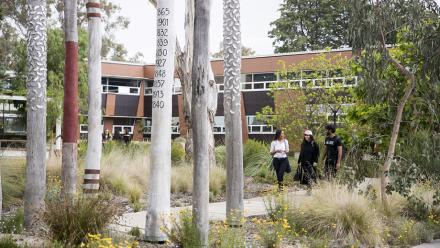DNA helps solve riddle of how clever crows craft tools
A clever piece of detective work by an international team, including a researcher from The Australian National University (ANU), has helped solved the mystery of which plants a population of crows on New Caledonia use to craft tools.
The crafty crows are well known for making their own stick tools with hooked tips to retrieve invertebrate prey from small holes and crevices.
The New Caledonian crow is the only non-human animal known to manufacture hooked tools in the wild.
"They put a lot of effort into making them. They use specific plants with forked stems, which they remove and then process into hooked tools for foraging," study co-author Dr Linda Neaves from ANU said.
"But they remove leaves and much of the bark, making it impossible to quickly identify the plant species."
While Dr Neaves' collaborators from the University of St Andrews in Scotland had been able to determine what plants the crows were using to make these tools at two of their long-term study sites, a third remained a puzzle.
"The plants used in one of the study sites is an introduced shrub, and in the other, they seem to use a variety of raw materials. But no one had ever seen the crows make the tools at the third site, so we had no idea what species it was," Matthew Steele from the University of St Andrews said.
After years of trying to work it out using a range of approaches -- including behavioural observations in the wild and in field aviaries, radio-tracking of birds, and working with local botanists to examine collected tools -- the crow team was at a loss.
That's where Dr Neaves comes in.
"The field team were able to collect some tools and approached myself and Professor Peter Hollingsworth from the Royal Botanic Garden in Edinburgh, Scotland, asking if DNA could be used to work out what plant it was," Dr Neaves said.
She managed to match DNA from the tools to a large native tree, Spanish Cherry, or Mimusops elengi.
"Because it's native, this may be one of the original plants used by the crows for making hooked stick tools. The field team later confirmed that temporarily captive crows happily crafted hooked stick tools from this plant," Mr Steele explained.
"It was amazing to finally work it out," Dr Neaves said.
"It was right in front of us the whole time. When the crow researchers first explained this problem, it was difficult to know if we could provide an answer. Usually you have a bit more to work with, in this case it felt like searching for a needle in a haystack - it could've been a large number of plants on New Caledonia."
Dr Neaves says it's a reminder of all the little things some species rely on to survive.
"Clearly these crows have adapted their remarkable tool-making abilities over time to make use of introduced plant species, and it is exciting to find this population prefers a native tree. It raises a lot of interesting questions about how and why crows select the plants they use and how this may be influenced by changes in their environment."
Professor Hollingworth says the study "demonstrates the broad usefulness of DNA barcoding for the essential task of separating and identifying plant species."
The long-term crow study was led by Professor Christian Rutz from the University of St Andrews, with expeditions for this study led by his PhD candidate, Matthew Steele.
The study has been published in PNAS.




